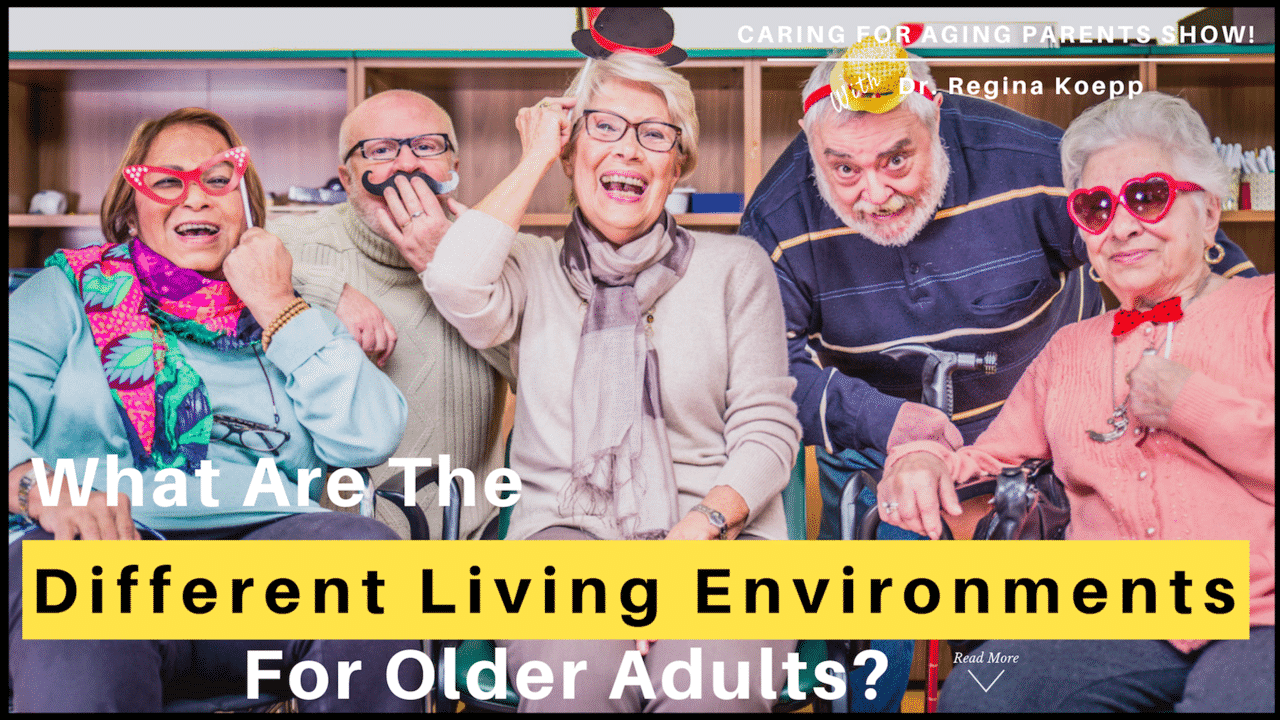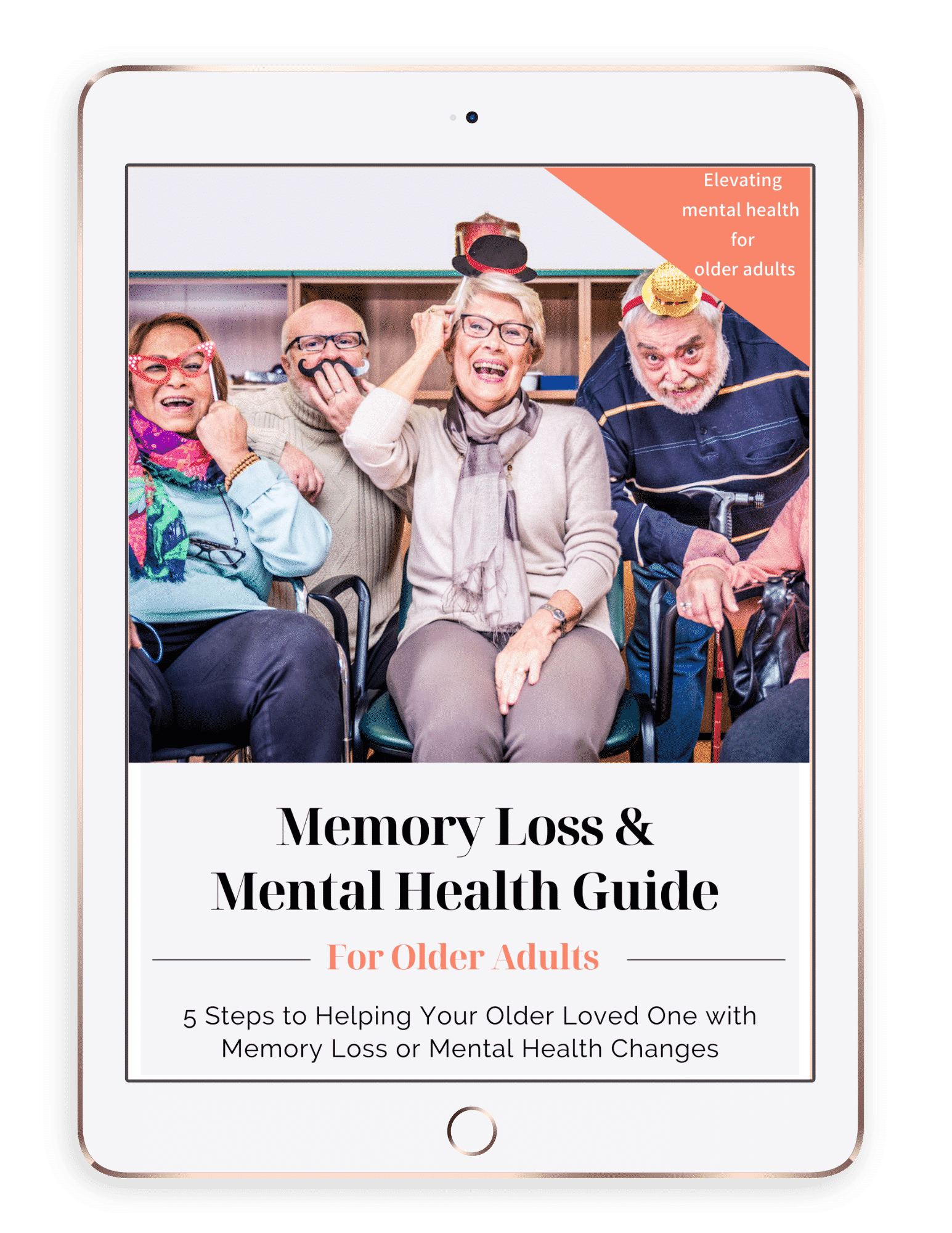Did you know that most older adults DO NOT live in Nursing Homes?
What?!!
That’s right!
In 2010, only 4.5% of older adults were living in nursing homes. But somehow there’s a misperception that most older adults live in nursing homes.
So, if they don’t live in Nursing Homes, where do where DO older adults live?
The vast majority of older adults (93.5%) live in…. (drum roll)…. the community!
Because there are so many misperceptions about where older adults live, I thought I would take this opportunity to describe the different environments that older adults live in!
Watch it here!

So, why is knowing the different living options for older adults so important?
- You need to know what options are available as your parents’ care needs change.
- Knowing options will help you to identify the best fit for your parents’ care needs
- Being familiar with options before you need them will help to increase your comfort in conversations with your parents about their living options. (The more comfort you have, the healthier the conversation is likelier to be!)
So, here they are…
The Different Living Environments For Older Adults!
1. Staying in Own Home/Aging in Place
Quite often people want to stay in their homes as they age and all the way until they die.
This could be a single family home, a condo, an apartment. It’s most typically a “home” in an all ages community (not a community that’s designated for older adults, per se). And so, this is called aging in place: Staying in your own home as you grow older!
With this option, as your parent needs assistance, you may think about having people check in and bring meals consistently (check out Meals on Wheels), hiring home health aides to assist with bathing and grooming, and a whole host of other in-home services that can help your parents stay in their home safely for as long as possible.
I’m working on a future episode devoted to resources to help your aging parents Age in Place. Stay tuned!
2. Living in a Family Member’s Home
Some families wish to have the older adult live in a family member’s home (or your own home). This could be because of cultural reasons, financial reasons, safety concerns, and so much more. Some families do this well, and other families struggle with lifestyle differences, lack of privacy, role changes, family stress, and so on. If you go with this option, consider the recommendations described above for aging in place.
I’m working on a future episodes discussing the challenges of adjusting to this option. As well as resources to help your aging parents Age in YOUR Home!
3. Senior Independent Living Communities
Senior Independent Living Communities can be apartments, cottages, condos, and single-family homes offered only for older adults. There is an age criteria (like over 55 communities, or over 65 communities). Each Senior Independent Living Community will have its own rules and regulations about their criteria for qualifying to live in their independent community.
Independent in this context means that the older adults who live in these communities are not receiving any assistance directly from the community itself. Meaning that if assistance is needed, it is not provided for by the community entity itself.
What is special about these communities, is that neighbors often look in on one another. These communities can be really happening and thriving places to live. Many of them have dining halls, recreation centers, exercise equipment, special interest groups, and social gatherings.
Who knows? Your aging parent might sign up for a social committee, lead a prayer group, or start an entomology club (this is the study of insects- my husband is an entomology nerd, which is the only reason I know this word)!
The cost for these communities vary depending on the how recently they were built, and the amenities offered and signed up for.
4. Assisted Living Communities
Assisted Living Communities offer what looks like apartment (or hotel) living in a community with lots of amenities. They offer assistance to the older adult with care needs, medication management, etc. These have many of the same amenities as Senior Independent Living, like a dining hall, recreational activities, gyms, pools, outdoor space, etc, but the key here is that assistance is provided. This might be in the form of a nurse to help administer medications three times a day. Or, maybe your aging parent has just discharged from the hospital and you want a staff member to check in on them; in assisted living communities there are staff members onsite to help. There also might be transportation to and from the doctor, the grocery store, or other community jaunts.
Assisted Living Communities are often the more expensive living environments and not typically covered by Medicare.
5. Personal Care Homes
Personal Care Homes are a cheaper alternative to Assisted Living Communities. These living environments offer board and care in single-family homes. The older adult might share a room or have their own (depending on what is affordable and available). There is often a caregiver on-site to help with meal preparation, bathing, dressing, medication management, etc. There are typically a handful of other residents sharing the home. This is often a cheaper alternative to Assisted Living Communities.
6. Memory Care Communities (or Units)
Memory Care Communities (or Units) are often connected to long-term care communities, like assisted living communities, but are located in a separate area (like a wing or a floor) and are often locked. They are designed to provide long-term care for people living with dementia disorders.
7. Continuing Care Retirement Communities (CCRC’s)
CCRCs are a combination independent living, assisted living, and nursing home care, all in one place. They tend to be on the more expensive side with lots of amenities and options. This option really meets the older adult where they are in terms of their level of ability. For example, your aging parent might start out in a condo living independently within the community of a CCRC, then a few years down the road, as things change, you parent might move into assisted living and live there for a while, then few years later into nursing home care, if needed.
A couple of benefits of living in a CCRC: By living in an environment like a CCRC, the older adult doesn’t have to move away from their friends and community when their care needs change. One other benefit to this option is that if your parents are married, for example, your mom may need skilled nursing, while your dad needs assisted living (or vice versa) and they can essentially live in the same community and see each other regularly. This might also make it easier on you given that your aging parents are more likely to be in one place for you to visit.
8. Nursing Homes
Nursing homes are for people who need a high level of nursing care, called skilled nursing, which might include assistance with grooming, dressing, eating, etc. Nursing homes are staffed with nurses, aides, and often have a physician who visits patients. Given that this is the highest level of care, medicare may cover some of the care provided in Nursing Homes.
Consider The Fit & Feel!
As you and your aging parents consider what type of living environment is right for them, I encourage you to visit these living environments to get a sense of which environments do your aging parents feel most comfortable and at home in.
It’s important to consider cultural, lifestyle, and personality factors as you visit living environments. For example:
Cultural Factors:
If your parent identifies as LGBTQ, you’ll want to have a clear sense that the community is affirming and your parent’s partner and/or friends would feel welcome.
If your parent speaks Spanish and enjoys Hispanic food, you’ll want to get a feel for how inclusive the senior community is related to Spanish speaking older adults. And, does the food and social connection appeal to your parent?
Lifestyle Factors:
If your parent smokes or drinks recreationally, will they be able to do so without feeling shame. Of course I’m not advocating smoking or drinking, but if your parent has the capacity to make their own decisions, does the community take a non-judgmental stance or a shaming one?
Personality Factors:
If your parent tends to be introverted, consider if the environment may be loud or overstimulating. If your parent tends to be more extroverted, consider if the environment is socially active enough to meet your parents needs and interests.
The bottom line is as you consider various living environments for your aging parents, it’s really important to pay attention to where your aging parent would feel most valued and comfortable, and feel like they could trust the care that they’re going to receive.
This is really important! Your parent is more likely to thrive in a senior community environment if they feel secure, valued, and trusting of the community and staff in these communities.




